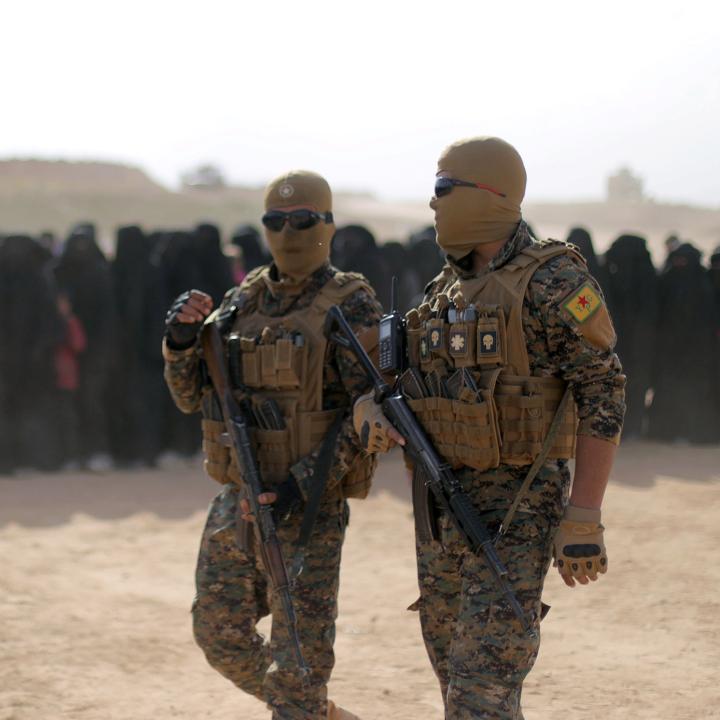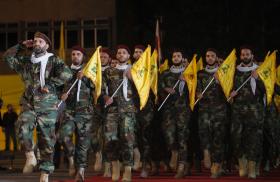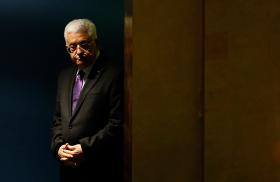
- Policy Analysis
- PolicyWatch 4025
Facilitating the New SDF Agreement Is Key to Stabilizing Syria

The Kurdish-led group has reached important understandings with the new leadership in Damascus, but finalizing and implementing them while resolving points of contention will require further help from the United States and its partners.
On March 10, Syrian Democratic Forces (SDF) commander Mazloum Abdi signed a tentative agreement with interim president Ahmed al-Sharaa to begin work on integrating the Kurdish-led group into the new Syrian army after months of U.S.-backed negotiations. Publicly welcomed by Washington, the European Union, the UN, and other actors, the agreement is key to Syria’s stabilization and economic recovery—neither of which is achievable without addressing the future of the SDF-held northeast, an area that includes 95 percent of the country’s oil and gas resources.
In signing the document, the parties agreed to eight main points that include recognizing the Kurds as an indigenous community, guaranteeing them citizenship and the attendant constitutional rights, integrating all civil and military institutions in the northeast (e.g., border crossings, Qamishli airport, oil and gas fields), ensuring the return and protection of internally displaced persons (IDPs), and enforcing a nationwide ceasefire. Joint committees will aim to implement the agreement by no later than the end of this year; the U.S.-led coalition against the Islamic State (IS) hosted an initial preparatory meeting at al-Shadadi base on March 19, and committee work is set to begin early this month.
Yet the barriers to implementing the agreement are legion, with Damascus and the SDF differing over the nature of future national governance (i.e., to decentralize or not), the degree of military integration (the SDF wants to remain autonomous), and the future of SDF control over Arab-majority areas and IS detention facilities—the latter being one of the biggest question marks in debates about the future U.S. military presence in Syria. Moreover, fighting continues between the SDF and Turkish-backed groups, with Ankara still opposed to an armed Kurdish presence along its borders—a posture that could shift significantly depending on the outcome of new Turkish efforts to reach a final peace settlement with the Kurdistan Workers Party (PKK), a group with hotly debated links to the SDF. Indeed, the entire framework of the Syrian deal could collapse during negotiations on any of these complex issues, making continued international involvement and encouragement essential to facilitating the tough work ahead.
Centralization vs. Federalism
While the groups that toppled Bashar al-Assad’s regime envision a centralized state, the SDF is hoping for decentralization—a tension reflected in their respective public statements and documents. In his January 29 “victory speech,” Sharaa stated that Syria’s “sovereignty will be imposed under one authority,” while the interim constitution adopted on March 13 emphasized preserving unity and criminalized any factions that call for “division” or request foreign support for their cause. The new charter also stuck with the formal name “Syrian Arab Republic” and failed to mention Kurdish political or cultural rights.
In contrast, a March statement by the SDF’s political wing, the Syrian Democratic Council, emphasized that the state should be decentralized. And in January, Abdi argued that Damascus should grant more autonomy to other regions of Syria, not just the northeast.
The majority of Syrian Kurdish factions—including the Kurdish National Council (KNC) and the SDF-affiliated Democratic Union Party (PYD)—agree on instilling some form of decentralization and reject the interim constitution as exclusionary. Yet their chosen models of federalism differ. Abdi has stated that Syrian Kurds do not seek a permanent autonomous government modeled after Iraqi Kurdistan. Long before Assad’s fall, the PYD set up a local entity now known as the Democratic Autonomous Administration of North and East Syria (DAANES), a multiethnic system based on the ideology of imprisoned PKK leader Abdullah Ocalan. The KNC’s proposed system is ideologically closer to Iraq’s Kurdistan Democratic Party.
Military Integration
The SDF has accepted nominal integration into the national military but prefers to maintain local command and control over Kurdish units. In January, interim Syrian defense minister Murhaf Abu Qasra rejected the SDF’s proposal to remain a separate military bloc. Yet following recent massacres against another minority, the Alawites, the government will have a tougher time convincing the Kurds to give up all of their military autonomy (particularly amid ongoing questions about which government forces were responsible for these killings, as discussed below). Another wrinkle is that Kurdish forces include an all-female unit, which will presumably be difficult or impossible to integrate given the Islamist worldview held by the new leaders in Damascus.
One compromise option is to reorganize the SDF into regional army divisions for those provinces under partial Kurdish control (e.g., Hasaka, Raqqa, Deir al-Zour). SDF commanders could be placed atop each division and retain local control, while still coordinating with Damascus regarding operations against IS, former regime cells, or Iran-backed elements.
The new government is also under pressure from elements who want it to reestablish control over Arab-majority areas currently held by Kurdish forces. Keeping a Kurdish-led administration in Hasaka could be understandable given that province’s mixed demographics, but Kurdish governance over heavily Arab communities in Raqqa and Deir al-Zour may become untenable now that locals no longer fear Assad’s return. Notably, the SDF-linked administrations in two Kurdish-majority neighborhoods of Aleppo reached an agreement with Damascus last week to defuse local tensions by withdrawing all military elements and empowering local police and security forces to “affirm coexistence and promote civil peace.”
IS Detainees
One crucial point not mentioned in the new SDF deal is the government’s claim that Damascus will take control of the northeastern camps and prisons holding an estimated 50,000 IS-affiliated fighters and civilians. Conversations with SDF sources indicate that they cannot determine the future disposition of these facilities on their own, since they are a core part of their longstanding mission with the U.S.-led coalition. Damascus and Turkey do not want the SDF to continue controlling camps and prisons, but the coalition will presumably balk at entrusting their security to a third party without a verified, credible plan.
For now, SDF officials have publicly stated that management of these facilities will remain unchanged. Therefore, the best option in the near term is to increase coordination on this issue and accelerate repatriation of non-Syrian detainees to their countries of origin until the Damascus-SDF agreement is implemented. Assad’s fall has also made it easier for Syrian IDPs in these camps to return to their communities.
Turkey and Its Proxies
As noted previously, a Turkish-backed group—the Syrian National Army (SNA)—has continued attacking the SDF in the Tishrin Dam area despite agreeing to integrate with the Syrian Defense Ministry after Assad’s fall. The SDF has also recounted further cross-border strikes by Turkish military forces.
Relatedly, the SNA presence in Kurdish-majority Afrin is making it difficult for thousands of Kurdish IDPs to return there. The group has reportedly carried out human rights abuses against those Kurds who stayed in the area, including arbitrary arrests, torture, kidnappings, and disappearances. SNA units even arrested Afrin residents who hosted officials from the interim government’s General Security Service (GSS) during a February 6 visit. That the group still operates separately from Damascus is also evident from accusations that SNA elements were responsible for the recent massacres against Alawites.
Therefore, the new Damascus-SDF joint committees should consider removing SNA units from Kurdish-majority areas like Afrin and replacing them with a mix of GSS forces and local Kurdish recruits. Government forces could also be deployed at contact points between the SDF and SNA, such as Ain Issa, Tishrin Dam, and Tal Tamer. Washington and other actors could pressure Turkey and Damascus to facilitate this arrangement, similar to how the Syrian army deployed to some of these locations after a Russian-mediated deal in 2019. Ankara should also be urged to fully relinquish its support for the SNA, since the Syrian government will never have command and control over the group’s forces so long as Turkey remains their principal sponsor. Rumors of a brewing Turkish ceasefire (both with the SDF and between the SNA and SDF on the Tishrin front) could facilitate all of these goals.
In addition, the Damascus-SDF deal could be facilitated by a successful peace and reconciliation process between Turkey and the PKK. Ankara argues that the SDF is merely a proxy of the PKK, a U.S.-designated terrorist group. The SDF denies this and claims that the PKK disarmament process is unrelated to its negotiations with Sharaa. Yet it also acknowledges that a PKK deal could bring a halt to Turkish attacks in Syria, since Ankara would theoretically be less concerned about a continued SDF presence along the border.
Conclusion
To improve the chances of successfully implementing the Damascus-SDF agreement, mediation by outside actors like the United States, France, and Germany will be critical—particularly on controversial joint committee issues, future power-sharing arrangements, and the thorny issue of decentralization. Washington could incentivize progress by offering sanctions relief to Damascus. The fact that the first committee meeting took place at a coalition base suggests that the United States is well-placed to play this role. It also points to the numerous benefits of maintaining an American military presence in the northeast, at least for the near future. Once Damascus and the SDF reach a final constitutional agreement and reassure coalition authorities that they have a plan for keeping pressure on IS and securing detention facilities, the Trump administration would be better positioned to act on its stated goal of withdrawing U.S. troops.
Wladimir van Wilgenburg is a reporter and analyst from Erbil, currently working as head of the news section at the Kurdistan Chronicle. His previous publications include the coauthored 2021 study Accidental Allies: The U.S.-Syrian Democratic Forces Partnership Against the Islamic State.



